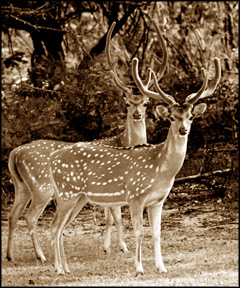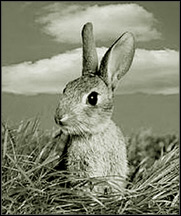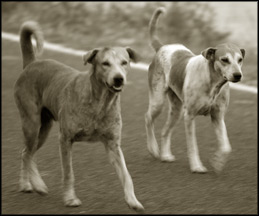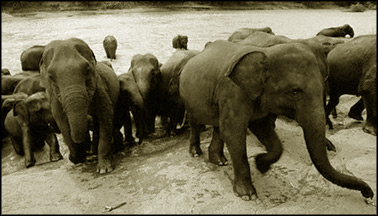Animals prophesy earthquake
K.G.H. Munidasa
 A stockbreeder in North China, a member of a peoples’ commune just 40
kilometres from the city of Tangshan, got out of bed before dawn on July
28, 1976 to feed his animals. When he walked inside the stable he found
that two horses and two mules were jumping up and kicking in the air, in
apparent distress. A stockbreeder in North China, a member of a peoples’ commune just 40
kilometres from the city of Tangshan, got out of bed before dawn on July
28, 1976 to feed his animals. When he walked inside the stable he found
that two horses and two mules were jumping up and kicking in the air, in
apparent distress.
Before long the animals broke loose and dashed outside. at that
moment a dazzling white flash illuminated the sky, followed by ominous
rumbling noises. The famous Tangshan earthquake of 7.8 magnitude had
struck.
This occurrence came to light in a survey conducted by Chinese
scientists of the earthquake-affected areas in and around Tangshan. The
survey initiated shortly after the `quake covered Tangshan and 400
communes in 48 counties around the city.
The scientists were able to collect information on 2,093 incidents of
unusual behaviour by animals in the time before the earthquake struck.
The stories were related by survivors of the devastating `quake
themselves, during interviews and discussions. Close studies of the
cases showed that 80 per cent of the incidents involved horses, donkeys,
mules, cows, pigs, goats, dogs, cats and other domestic animals.
However, it was also found that just before the `quake wild weasels
in their hundreds left their underground lairs, despite the presence of
man, carrying their young either on their back or in the mouth. The
fishes in aquariums became restive and those in ponds came to the
surface of the water, dashed about aimlessly or leaped into the air.
 Domestic goats belated mournfully refusing to go inside their pens,
while those inside tried to get out. Cats ran about mewing desperately
or even scratched their owners, while some picked up their kitten in the
mouths and scampered outdoors. Domestic goats belated mournfully refusing to go inside their pens,
while those inside tried to get out. Cats ran about mewing desperately
or even scratched their owners, while some picked up their kitten in the
mouths and scampered outdoors.
The dogs scratched at the doors of houses to get inside, but when let
in they barked furiously and even bit their owners. Some scurried away
holding pups in their mouths. Pigs screamed and broke out from their
sties, either by squeezing under grates or jumping over the walls. The
chicken dashed out of the coops in the dead of night to perch on
rooftops or trees.
In the countryside rats who were normally sensitive and wary, left
their holes in droves and scampered to safety.
The survey revealed that the unusual behaviour of the animals reached
its climax in the 24 hours immediately before the `quake. However, in
previous earthquakes where foreshocks preceded the main `quake
behaviourial variations in animals like rats, fish and snakes occurred 2
to 3 days before or even earlier.
Precursory signs
It was after the major earthquake in the Hsingtai county in Northern
China in 1966 that the Chinese scientists initiated studies on the
precursory signs of animals to predict earthquakes. It has been found
that before the 6.8 magnitude Hsingtai `quake all the dogs at a village
in the epicentre deserted their kennels and so survived the catastrophe.
Reactions
 In the years following the Hsingtai earthquake a national
retrospective survey was launched by Chinese scientists to study the
animal behaviourial variations. They visited places which were hit by
destructive earthquakes in the first half of 20th century, interviewing
older people and gleaning whatever information that was available. In
their preliminary report they identified 58 kinds of domestic and wild
animals which had shown unusual behaviour before the `quakes hit. In the years following the Hsingtai earthquake a national
retrospective survey was launched by Chinese scientists to study the
animal behaviourial variations. They visited places which were hit by
destructive earthquakes in the first half of 20th century, interviewing
older people and gleaning whatever information that was available. In
their preliminary report they identified 58 kinds of domestic and wild
animals which had shown unusual behaviour before the `quakes hit.
It is on record that before the 8.5 magnitude earthquake, Chinese
biggest, struck in Haiyauan in 1920 wolves ran about in packs and
sparrows flew about in the air twittering wildly.
An old man got up at night to find out why his dogs were barking in a
most unusual manner. No sooner had he left the house the `quake struck
and he survived.
Dr. Eberhard Schmmdes of the Seismographic Observatory at
Fuerstenfeldbruck is said to have received more than 70 letters from
members of the public telling of unusual animal behaviour at the time of
earthquakes in other parts of the world. According to these letters
rabbits sought shelter, dogs got frightened and cats became nervous.
Dr. Eberhard, however does not believe that an early warning system
based on peculiar animal reactions can be relied on. “However, it is
known that some animals reacted to earth tremors 20 seconds earlier than
man and registered movements of the earth man did notice,” he has
contended.
There had been no serious research in this field. Yet, Munich
Zoologist Dr. Theodor Haltenorth is of the opinion that domestic animals
indicted by unusual behaviour, days and hours ahead of an impending
`quake. His advice is to pay more attention to whatever animal you keep
and make use of its forecasting ability.
In 1968, China established its first experimental station in Hsingtai
for earthquake prediction, making use of observations on biological
forms. A similar zone was set up in 1971 in Aksu, Sinkiang, where
earthquakes were expected to occur. Biophysicists there experimented
with about one-hundred pigeons.
Zoologists at Munich’s Heliabrunn Animal Park were once astonished to
see that a two-metre long Arapaima (South American fresh water fish) had
broken through the wire-mesh cover of the aquarium and perished.
The incident occurred shrewdly after 6 in the morning. Soon
afterwards tremors were registered in Munich from an earthquake in the
State of Baden-Wuerttmberg which shook the walls in the city and tore
people from their sleep.
Tsunami calamity
 According to a Thailand datelined Reuters news story, carried in a
Lakan daily, tame elephants deployed as mounts for tourists at Khao lake
beach resort started trumpeting the moment 9.0 magnitude earthquake
cracked open the sea bed off Indonesia’s Sumatra Island, creating the
tsunami. According to a Thailand datelined Reuters news story, carried in a
Lakan daily, tame elephants deployed as mounts for tourists at Khao lake
beach resort started trumpeting the moment 9.0 magnitude earthquake
cracked open the sea bed off Indonesia’s Sumatra Island, creating the
tsunami.
The elephants soon calmed down, but started wailing again in about an
hour later as the big wave came rushing towards them “Those with
tourists aboard, others even lifting them off the ground with trunks
onto their backs, headed for the jungle-clad hill behind the resort
beach, where at least 3,800 people (more than half of them foreigners)
would soon have been killed. The elephants who were not working broke
their hefty chains and followed suit,” the report said.
They charged up the hill through the jungle and then stopped. The
tsunami drove up to 1 km, in shore from the gently sloping beach and
stopped short of where the elephants stood.
Sixth sense
 Another Reuters news story from Johannesburg quoting Sri Lankan
sources said that the giant waves, which killed over 24,000 people along
the island’s coast had seemingly missed the wild beasts,with no dead
animals having been found. Another Reuters news story from Johannesburg quoting Sri Lankan
sources said that the giant waves, which killed over 24,000 people along
the island’s coast had seemingly missed the wild beasts,with no dead
animals having been found.
A Deputy Director of the Department of Wildlife H.D. Ratnayake had
told the Reuters “No elephants are dead, not even a dead hare or rabbit.
I think animals can sense disaster. They have a `sixth sense’ and known
when things are happening.”
The notion of an animal sixth sense - or some other mythical power -
is an enduring one which the evidence on Sri Lanka’s battered coast is
likely to add to,” the news story concluded.
(Based on facts gleaned from books and other published sources).
|

